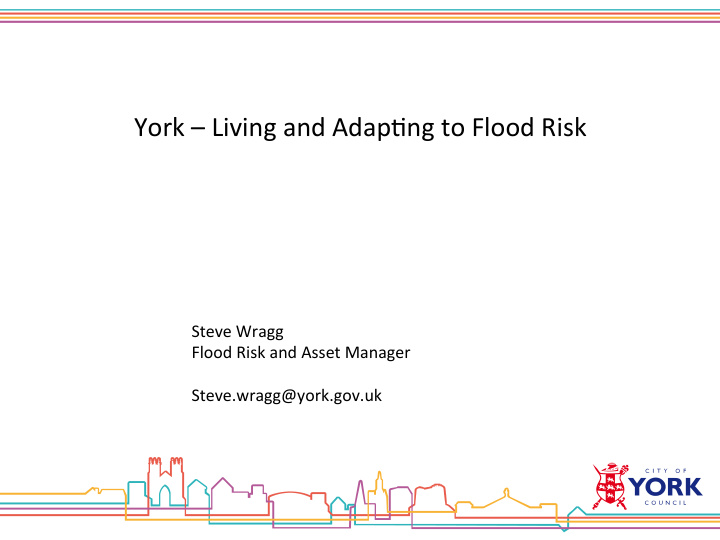



York – Living and Adap0ng to Flood Risk Steve Wragg Flood Risk and Asset Manager Steve.wragg@york.gov.uk
York - a long history of flooding 1892 2000 1947 1982
10.5 6.5 7.5 8.5 9.5 10 11 6 7 8 9 1885 1890 1895 1900 1905 York - a long history of flooding 1910 1915 1920 1925 1930 Viking Annual Max 1935 1885-2015 1940 1945 1950 1955 1960 1965 1970 1975 1980 1985 1990 1995 2000 2005 2010 2015
Our Boxing Day experiences • More than 430 flooded residen0al proper0es • 190 flooded commercial proper0es • The south east of the city was impenetrable for all traffic
Our Boxing Day experiences • Forecas0ng did not fully predict the outcomes • Second highest levels on the Ouse, Boxing record levels on the Foss Day • Foss Barrier overwhelmed • Boxing Day, difficul0es in responding • Major communica0on issues following Record Major the loss of the local York exchange and wider infrastructure in Leeds River Comms • Loss of Yorkshire Water Castle Mills Levels Failure Pumping Sta0on • Risk to electricity network • Command and control accommoda0on and comms issues
Our Boxing Day response • 13,000 sandbags with mul0ple deployment to over 200 loca0ons across the city, many loca0ons flooded that have not been affected since the barrier was built in the 1980’s • 40 front line opera0ves on Boxing Day ensuring strategic flood temporary flood defences were deployed, 63 road closures and support provided for the vulnerable • Rest centre set up and staffed for three days • Coordina0on of more than 600 volunteers throughout the event and post event clear- up • Skips deployed throughout flooded loca0ons and emp0ed regularly • More than 900 proper0es visited in the immediate aZermath to iden0fy support needs, vulnerable resident and business needs and begin to administer support and financial grants • More than £500k in resilience grants, £300k council tax and £1.3m business rate relief administered • Rapid clean up and re-opening of all strategic traffic routes • CYC officers a^ending a range of flood mee0ngs, surgeries and events to gather issues and provide support • Independent review commenced
Managing risks, managing expecta0ons Historic flooding versus modern day flooding, it looks the same but do our residents, businesses and visitors now expect so much more...? Our heritage assets have seen this many 0mes – are they resilient?
Managing risks, managing expecta0ons Trust – many thought they were safe from flooding and it would never happen to them Involvement of ci0zens - key to expand the reach of the finite resources of all partners New communica0ons issues – Very high ‘e-par0cipa0on’ in the event, ac0ve social media networks were very effec0ve but actually placed even more burden on the council to monitor, respond and ac0on A community based model is well placed to be^er understand the likelihood and impact of flooding and be more resilient to future flood events e.g. Flood Wardens
Looking Forward – reducing the impact • Long term investment needed in our exis0ng flood risk management assets • Certainty of Defra funding models and wider benefits criteria used in appraisals • Be^er resilience in place in all plans • Safer communi0es supported by effec0ve warning and informing procedures and resilient community planning • York is fully open for business and we embrace our rivers and waterways
Looking Forward – slowing the flow Upstream management is key to provide a resilient network of localised defences be^er able to withstand future clima0c change scenarios • Future climate change scenarios • Catchment wide interven0ons – how do we make it pay? • Property level resilience and resistance measures in everyday planning guidance not just via post flood event grants • What extreme scenarios are we now planning for?
Na0onal Flood Resilience Review
Malmo, Sweden Enschede, The Netherlands Portland & Milwaukee, USA
Barriers to delivery Sustainable Drainage Systems Planning – geing the right ‘hooks’ in place, desires and vision of the decision makers Cost – versus ‘conven0onal’ methods and the current global downturn Fears of Health & Safety issues, maintenance liabili0es and long term costs ‘We have always done it like this…’ Public health fears – contamina0on, increased insect life, ‘stagnant water’ etc Flood Resilience Reac0ve funding, no direct funding op0ons for retrofit outside of flood events No legisla0on driving implementa0on through planning / building control process No direct links with insurance savings Concerns from home owners and need to accept that a property is at risk of flooding and take proac0ve steps to reduce the impacts of flooding
Champions and Behaviours Within the current legisla0ve and financial climate delivery is reliant on the work of champions and advocates to promote the need to do something ‘different’ Even with legisla0ve and financial support we need to begin thinking differently and see water as an opportunity and a valuable commodity, not a threat
Ques0ons? Steve Wragg Flood Risk and Asset Manager steve.wragg@york.gov.uk
Recommend
More recommend